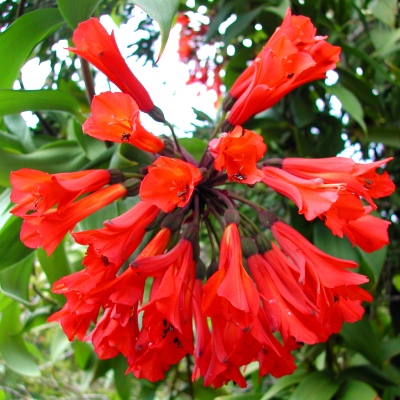| Home |
Strange Wonderful Things Rare and exotic plants |
 |
|---|
Bomarea
Please be careful removing your plant from its packaging
Soil -- Bomarea likes humus-rich, well-draining soil. Regular potting soil is okay, or you can add extra compost (well-decomposed) provided that you balance it with perlite or pumice rock, for more drainage. Avoid lime, since Bomarea likes slightly acid soil.
Transplanting -- Bomarea is sensitive to having its roots disturbed, so transplant carefully. Move the plant to a 1 gallon container, which will hold it for at least a few months. Do not compact the soil after transplanting. Water it in but do not feed until the plant puts out new growth. Work it up to larger pots as it grows, until it's eventually in a 5-15 gallon pot after 1-2 years.
Watering -- Bomarea likes soil that's evenly moist, but not soggy. Tap water can be high in minerals and other chemicals, so i recommend using bottled water or rain water for at least the first few months. Then you can switch to tap water if you'd like, provided that it isn't filtered with a water-softening filter like Pür or Brita, which add sodium (if the box says "ion exchange filter," avoid it).
I recommend using a moisture meter probe, which you can get from most garden and hardware stores for about $5. You simply stick the probe down to the root level and read the dial. I water when it's about halfway dry. Do not let the soil dry out.
Light -- Bomarea comes from the forests, where it gets tree-filtered sun most of the time. Aim for about 40-50% sun. Avoid prolonged midday sun exposure, except along the Pacific coast.
Climate -- Bomarea is happiest between 40 and 80 degrees. The roots can take several degrees of frost, but it will kill the leaves. It's best to protect the plant from all frost.
It warmer climates, give it plenty of mid-day shade, and don't plant it where heat can collect, like against a sunny wall. Mulch the plant to keep the roots cool and moist. Shade the pot to keep it cool, or at least avoid using a black pot, which can overheat.
Fertilizing -- During periods of active growth, give feedings with ordinary vegetable fertilizer or the equivalent, following the label's recommended dosage carefully. It's normal for a some the older leaves to yellow and die throughout the year, but if it seems excessive, it could be from not enough fertilizer (nitrogen) or under-watering.
Up and away -- Bomarea likes to climb, so give it something to play on, like a trellis, fence, or another plant. It should ideally be under 1" thick, so the plant can twine it's way around easier. Don't prune your plant (unless a branch dies back), but you can wrap any long strands around your trellis. The flowers appear from the growing tips.
Pests to watch for -- Snails and slugs can be a problem in prone areas. Watch for aphids or possibly other bugs.
Feel free to email if you have any questions.
Good growing!
Jeff
Strange Wonderful Things
| Home |
Strange Wonderful Things Rare and exotic plants |
|
|---|---|---|
| Entire site Copyright 2003-2025 by Strange Wonderful Things, except as noted | ||

